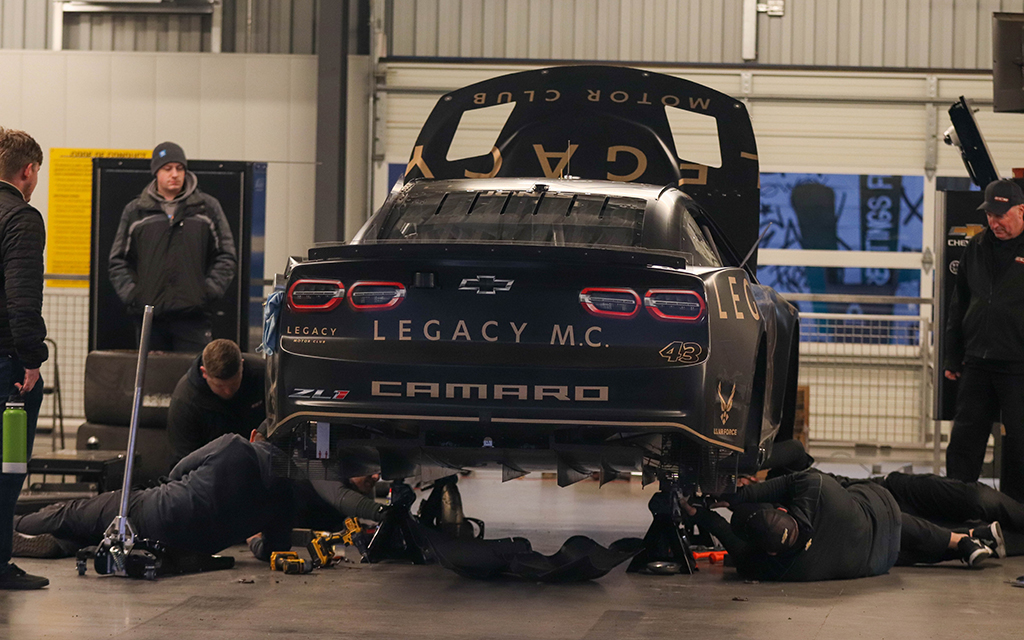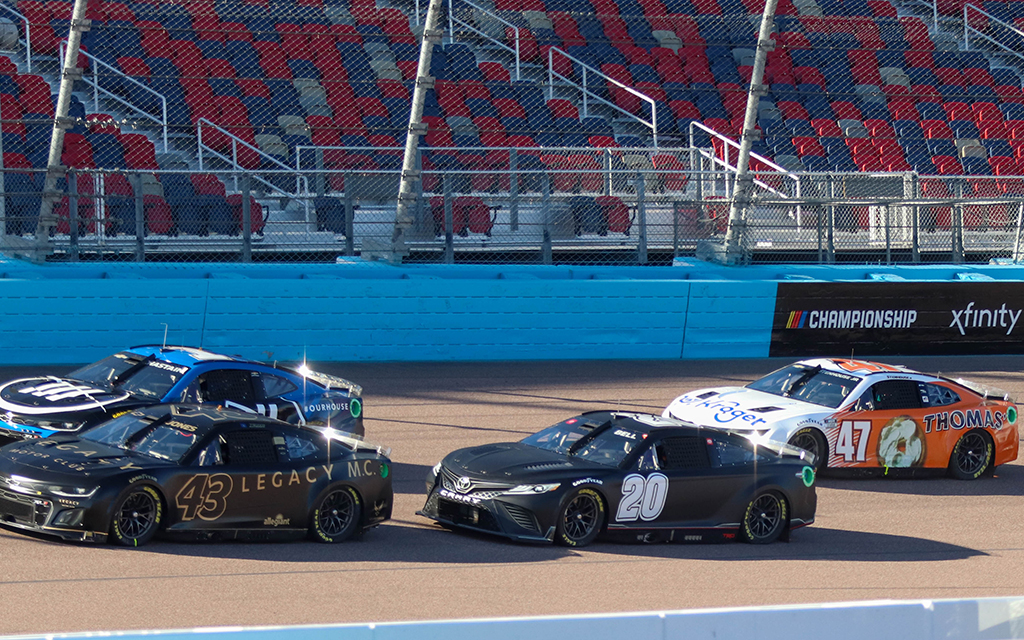
Brad Keslowski turns laps at NASCAR’s testing in Phoenix in late January. Keslowski wrecked on the final lap of Sunday’s Daytona 500. (Photo by Reece Andrews/Cronkite News)
AVONDALE – As Ricky Stenhouse Jr. celebrated Sunday’s Daytona 500 victory, and the track cleanup crew finished between turns one and two, NASCAR breathed a sigh of relief.
The climax of Sunday’s 65th running of the Daytona 500 delivered a familiar conclusion: drivers smashing into the wall, cars spinning and the caution flag coming out. Luckily for NASCAR, every driver walked away unscathed – something NASCAR couldn’t claim by the end of last season.
In a sport defined by its evolution, NASCAR has widely been considered one of the safer motorsports in the world. So after NASCAR experienced three driver concussions, along with multiple complaints from drivers, it was evident the 75-year-old racing circuit needed to make up the ground it once held in safety.
“Late summer and early fall, we got to a point where we really had to kind of get our attitude somewhat addressed and readjusted with the drivers,” said Brandon Thomas, Vice President of Vehicle Design for NASCAR. “They came to us like, ‘We gotta talk, we got to sit down and talk,’ and we did that. They were painful conversations to start with, and what it ended up doing was opening up a lot of great dialogue.”
In a sport as gritty as NASCAR, speaking up about safety can be uncomfortable for drivers. NASCAR has tried its best to eliminate that stigma and improve communication related to safety.
“We’ve got them back to the point where they feel comfortable coming straight to us and talking, and we listen to what they have to say, we engage, we talked about that stuff. That helped us really take their experience and say, “OK, this is the stuff we really feel like you need to work on,’” Thomas said. “It helps us kind of focus our attention on what’s important to them, and it helps us also kind of convey to them, ‘Here’s our knowledge base, here’s the things we have worked on, let’s all let’s all understand more.’”
The transition from the “Gen-6” era to the “Gen-7” era has been arguably the most dramatic transition throughout the seven generations of stock cars. The new-age race car fans see on the track is the closest race car to a production car that can be bought at a dealership.
However, NASCAR is a contact sport, with safety being the top priority. The car produced great racing and the most winners in a single season, yet a cloud hung over the sport heading into the offseason.
“Year one of competition, the car car did great, put on great races, good shows, felt like the fan response was awesome. A lot really big, positive things out of our events,” Thomas said. “It was literally a full new design bumper to bumper, every component on the car was something new. So as we’ve worked through the fall, we started addressing a lot of driver complaints about rear impacts, things like car-to-car hits in traffic. Our brand of racing is full contact, so these guys are bumping into each other quite a bit.”
Drivers and teams have noted the race car’s lack of “crushability,” specifically in the rear clip of the car. The name of the game for Thomas and NASCAR’s engineers is disbursement of energy. If the energy has nowhere to go, the more violent the impact is felt by the driver.
“We did some design updates to the rear clip, basically to promote a lot more deformation in certain high energy crashes, some design changes in the center section of the car, that’s really the safety cell where the driver sits,” Thomas said. “Same rationale, promoting some deformation in these big hits. Then we did some design updates to the bumper to try and manage kind of the energy in like the lower to medium energy hits. So we’re trying to attack multiple scenarios with multiple solutions.”
The oddest part of NASCAR’s situation was the softer wrecks resulting in driver injury while more violent wrecks had been seen throughout the season without injury.
The rules of the sport allow for plenty of contact, so much so that it’s difficult for viewers at home and at the track to understand how much “beating & banging” goes on throughout a race, increasing potential opportunity for injury.
“You remember every big crash from the season because there’s not many. The car-to-car stuff happens, 10, 20 times during a race to a particular car. Lap after lap, these guys are bumping into each other,” Thomas said. “So there’s a lot more frequency of that type of stuff happening, so there’s a lot more scenarios where the driver is commenting to us, ‘Hey, you know, this was okay, but that wasn’t’.”

Mechanics for Jimmie Johnson’s team go to work following NASCAR’s testing in Phoenix in late January. Johnson returned to racing at Sunday’s Daytona 500. (Photo by Reece Andrews/Cronkite News)
Arizona’s own Alex Bowman and 2004 Nextel Cup Series Champion Kurt Busch were the first two drivers to suffer concussions last season. Busch called it a career due to his injury, whereas Bowman returned for the final race of the season in his home state.
Bowman’s injury was not only due to the car’s stiffer build but also the positioning of the headrest. Bowman missed five races in the 2022 playoffs while healing from his concussion. Prior to his return race, Bowman remained confident his team had made the proper adjustments inside the vehicle.
“Yeah, we changed some headrest stuff, some helmet stuff, just trying to be as preventative as we can,” Bowman said. “I think there’s a lot of really smart people at (Hendrick Motorsports) that kind of went through and evaluated everything and we’re just trying to make everything the best it can be.”
The third driver to suffer a concussion was Tyler Reddick. At Homestead-Miami Speedway in October, the future driver of 23XI’s No. 45 Toyota barrelled into the inside wall, resulting in a hard collision. The very next week at Martinsville Speedway, Reddick radioed to his team that he hadn’t felt right since the last restart where he got caught in a stackup.
Both of Reddick’s wrecks play a pivotal role in figuring out the issue. The impacts in the two crashes were to the front of the car as opposed to rear impacts seen in Bowman and Busch’s incidents.
Reddick was wearing a mouthpiece with a sensor at Martinsville, in hopes NASCAR could gain further clarity of the impacts being felt.
“Based off what you can see from the mouthpiece sensor data, it looked like what you’d see in a pretty significant crash,” Reddick said. “It didn’t feel good. I knew it wasn’t 100%. Normally when you have bumps or whatever it might be you kind of just keep going, but that one felt different so definitely the right call to get out of the car, because when I did I wasn’t OK.”
Reddick didn’t have to wait long to find out if NASCAR’s fixes worked, as he wrecked out of the Daytona 500. In his post race interview, Reddick assured viewers he was OK, signaling NASCAR has found the fix.
NASCAR’s passed its first test, but another one awaits Sunday in Fontana, California as the field is set to compete in the Auto Club 400.



